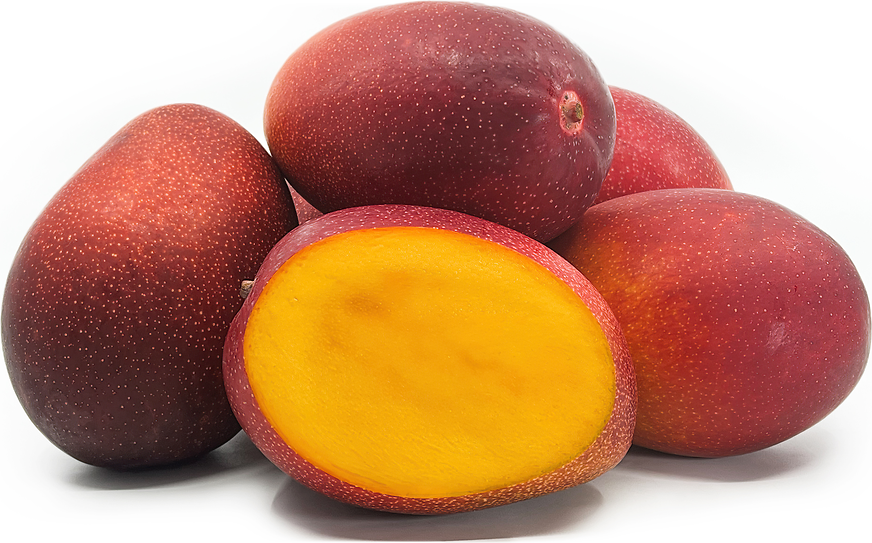Gardenshoppy
Miyazaki Mango
Miyazaki Mango
Couldn't load pickup availability
Miyazaki mangoes are a premium, medium to large-sized variety, typically weighing between 350 to 510 grams. They feature a round to oval shape with gently curved, blunt ends. The skin is smooth, semi-thick, and leathery, displaying a vibrant palette that ranges from dark red and ruby red to shades of orange. This vivid coloration varies depending on the growing conditions and exposure to sunlight during cultivation. Tiny pale yellow dots speckle the surface, and the skin is known to peel away with ease.
Inside, the flesh is a bright, rich orange—soft, juicy, and tender with a smooth, non-fibrous texture that melts in the mouth. At the center lies a flat, oval to oblong seed, which is inedible and should be discarded. When ripe, Miyazaki mangoes emit a fragrant, honeyed tropical aroma.
These mangoes are sold fully ripe and prized for their exceptionally high sugar content, often measuring at least 15 degrees Brix. Their flavor is a perfect balance of sweetness and tartness, with layered tropical notes reminiscent of coconut and pineapple. When selecting a Miyazaki mango, choose fruits that feel heavy for their size and avoid those with large black spots, which may indicate overripeness.
🌞 Growing & Care Guide for Miyazaki Mangoes
☀️ Sunlight & Soil
- Thrive in full sunlight, essential for developing the fruit’s signature deep red color
- Grown in climate-controlled greenhouses to simulate tropical conditions
- Mirrors are sometimes used to maximize sun exposure and deepen skin color
- Prefer well-drained, fertile soil
💧 Watering
- Require consistent watering, especially during fruiting
- Greenhouse cultivation ensures controlled hydration levels
- Avoid water stagnation to prevent root rot
🌱 Fertilization
- Benefit from balanced nutrient-rich fertilizers
- Key nutrients include potassium, calcium, magnesium, and iron
- Enhances sugar content and fruit quality
✂️ Pruning
- Regular pruning helps maintain tree shape and improve air circulation
- Encourages better light penetration, aiding in uniform fruit ripening
🍂 Mulching
- Organic mulch helps retain soil moisture and regulate root temperature
- Minimizes weed growth and adds nutrients to the soil over time
🐛 Pest & Disease Control
- Protected by greenhouse environments, reducing common pest threats
- Vigilance still needed against fruit flies, mildew, or root rot
- Netting protects ripe mangoes from falling damage and pests
🌱 Support for Young Trees
- Young trees may require structural support in early stages
- Greenhouse cultivation allows for gentle handling and ideal conditions
🍎 Harvesting
- Left to naturally ripen on the tree, ensuring maximum sweetness
- Harvested only when fully ripe—fruits drop gently into protective nets
- Handled with care to preserve delicate skin and flesh
🍃 Thinning
- Selective thinning ensures only premium-sized mangoes remain on the tree
- Improves nutrient allocation and results in higher sugar concentration
❄️ Winter Protection
- Grown exclusively in temperature-controlled greenhouses to guard against frost
- Ideal for regions that cannot support open-field mango cultivation
📦 Why Choose Miyazaki Mangoes?
- 🌈 Exceptional sweetness with sugar content reaching 15°+ Brix
- 🍑 Melt-in-your-mouth flesh—non-fibrous, juicy, and vibrant
- 🎁 Branded luxury fruits like Taiyo no Tamago sell for up to $4,000/pair
- 🌞 Cultivated using sunlight-enhancing techniques for perfect ripening
- 🇯🇵 Grown with meticulous care in Miyazaki Prefecture, Japan
- 🎉 Celebrated annually on Miyazaki Mango Day (May 25th)
- 💎 Each mango is a symbol of craftsmanship and premium quality
- 🛒 Available in high-end department stores and luxury fruit markets
Share


